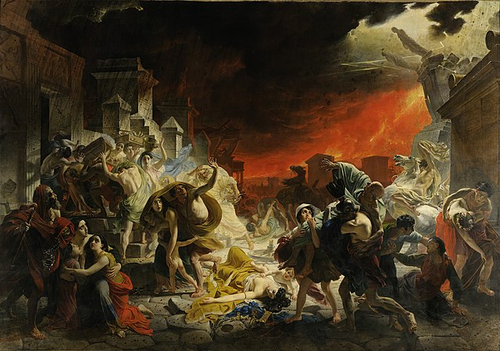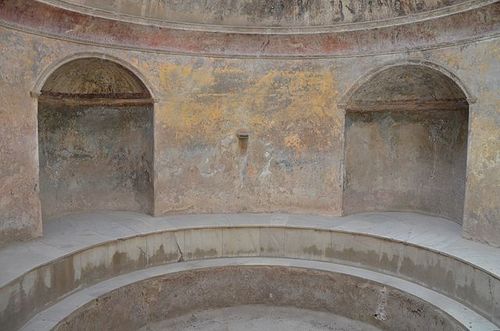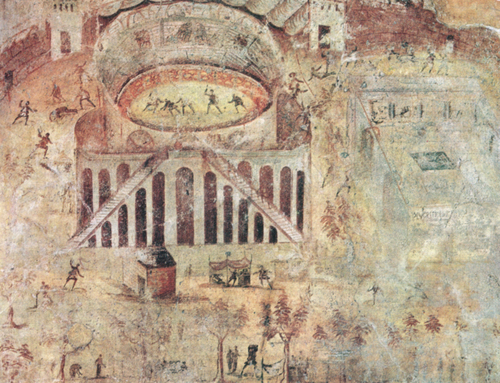Noiser
What Life Was Like in Pompeii
Play Short History Of... Pompeii and the Vesuvius Eruption
The city of Pompeii is perhaps most famous for the volcanic eruption that destroyed it in 79 AD. But have you ever wondered what life was like in Pompeii before the blast?

Eating Out
Archaeologists have excavated around 160 bars and cafes within the ruins of Pompeii. Beautiful decorations remain—vividly painted images of roosters and scenes from myths can still be seen on the walls. Some of the cafes were big enough to sit in; others seemed to serve only as takeaways, with a countertop facing the street.

The people of Pompeii ate a variety of foods. Standard fare was bread, cheese, olives, figs, salted fish, eggs, and various fruits and vegetables. Meat was less commonly eaten, though there is evidence that dishes featuring pork and goat were popular. For the more adventurous diner, exotic menus featuring dormice doused in honey and sea urchin were also available. These would have been reserved for the wealthy patrons of the town, but it’s thought that the poor frequented cafes the most. Their small, almost unusable kitchens meant they were forced to eat out regularly. At least that saved on the washing up!
Keeping Clean

Pompeii was home to at least five public bathhouses. These were popular all over the Roman Empire as places not just to get clean but also to conduct business, discuss politics, and play board games with friends. Some of the bathhouses in Pompeii were owned by the council, while others were built by the wealthy for private use. The ones open to the public cost little, meaning people from all walks of life could visit. Here, slaves rubbed shoulders with free women and gladiators.
The term bathhouse is a tad misleading—the buildings actually served as a sort of modern-day gym. There were swimming pools, cold rooms (frigidariums), warm rooms (caldariums), exercise spaces, and even massage rooms. Getting clean was a long process, involving a variety of different rooms, pouring oil over your body, and then scraping it off with a metal instrument.
Despite how lovely this all sounds, there was one pretty major downside. Throughout the day, the facilities quickly became unsanitary due to heavy use and a lack of proper water treatment methods like modern chlorination. Doctors even advised townspeople with wounds against taking a dip in the murky water, as this could lead to infection, gangrene, and possible amputation. Luckily, the Romans were a clever bunch and, through years of trial and error, made adjustments to improve hygiene.
Gladiator Battles

Pompeii is home to one of the world’s oldest stone amphitheatres, built around 70 BC. It could accommodate up to 20,000 people in varying degrees of comfort. While it was basic, compared to the more elaborate structures that would follow, it was still a marvel of engineering.
An inscription on the amphitheatre states that its purpose was to “demonstrate the honour of the colony." Honour, in this case, meant gladiator battles in which men were pitted against each other in fights that could end in death. Some were even made to battle wild, snarling animals. Paintings on the stone walls acted as advertisements for the gladiators, who were the celebrities of the day. But the violence was not always contained to just the sand in the centre of the amphitheatre.
Pompeii's amphitheatre hosted gladiatorial games, where locals competed against rivals from the neighbouring town of Nuceria. Much like modern-day football matches, excitable rival fans enthusiastically shouted abusive chants at each other as their heroes strove for glory in the arena. High spirits, fueled by the Neapolitan sun and local wine, frequently escalated into something more sinister—riotous violence that resulted in numerous fatalities. In response, authorities in Rome banned Pompeii from holding gladiatorial games for ten years. However, Emperor Nero lifted this ban early.
Theatre

If bloodshed was not your thing, the theatres in Pompeii offered different types of entertainment. The 10,000-seat Odeon hosted comical plays and mimes, a short form of satirical entertainment that was very popular with the locals. If you were after something of a little more substance, you could get a ticket for the latest tragedy at the nearby Quadriporticum.
During the reign of Augustus, the seating platforms were covered entirely in marble to exude a sense of opulence. There were even boxes built so the very rich could enjoy the performances away from the common folk. Much like modern-day theatres, the remaining seats were divided into sections based on how much you were willing to pay. A temporary canvas would be erected on especially hot days to shield the theatregoers from the sun.
Graffiti

Just as people do today, the ancient inhabitants of Pompeii were eager to leave their mark on the town. In all, archaeologists have uncovered over 11,000 different bits of graffiti. Some are legitimate means of communication (friends leaving messages for one another to arrange meet-ups and drinking sessions); others are the types of graffiti we are more used to.
Many walls are decorated with people’s names, crude drawings of ships, Roman numerals, and even a very realistic rendering of Medusa. There are sweet messages from two friends, Gaius and Aulus, enjoying each other’s company in a bar. Early food critics scrawled on the walls of restaurants, warning future customers of the poor-quality food on offer (one goes so far as to call the food poison!). In brothels, customers scribbled boasts about their pleasure-filled experiences on the walls. Insults flew back and forth, with one man deriding another as a eunuch, only to receive a stinging retort about his own baldness.